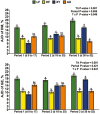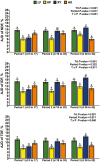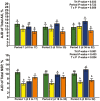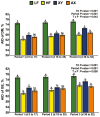Unveiling the influence of adaptation time on xylanase and arabinoxylan-oligosaccharide efficacy: a study on nutrient digestibility, viscosity, and scanning electron microscopy in the small and large intestine of growing pigs fed insoluble fiber
- PMID: 37991108
- PMCID: PMC10783243
- DOI: 10.1093/jas/skad378
Unveiling the influence of adaptation time on xylanase and arabinoxylan-oligosaccharide efficacy: a study on nutrient digestibility, viscosity, and scanning electron microscopy in the small and large intestine of growing pigs fed insoluble fiber
Abstract
The experiment objective was to evaluate the impact of xylanase over time on viscosity and digestibility in growing pigs fed corn-based fiber. Twenty gilts with an initial body weight of 30.6 ± 0.2 kg (n = 5 per dietary treatment) were fitted with t-cannulae in the medial jejunum and terminal ileum, housed individually, and randomly assigned to one of four dietary treatments: low-fiber control (LF) with 10.4% total dietary fiber (TDF), 30% corn bran high-fiber control (HF; 26.4% TDF), HF + 100 mg xylanase/kg (XY; Econase XT 25P; AB Vista, Marlborough, UK), and HF + 50 mg arabinoxylan-oligosaccharide/kg (AX). Gilts were limit fed for three 17 d periods (P1, P2, P3); each included 5 d adaptation, 2 d fecal collection, 3 d ileal collection, 3 d jejunal collection, and 4 d related rate of passage study. Data were analyzed as repeated measures using a linear mixed model with surgery date as a random effect, and dietary treatment, period, and their interaction as fixed effects. Jejunal and ileal digesta viscosity did not differ among dietary treatments or periods (P > 0.10). There was a dietary treatment × period interaction for the apparent jejunal digestibility (AJD) of dry matter (DM), gross energy (GE), insoluble dietary fiber (IDF), neutral detergent fiber (NDF), total arabinoxylan (T-AX), total non-starch polysaccharide (T-NSP), and TDF (P≤ 0.05). In P1, LF had the greatest AJD of DM (15.5%), and relative to HF and AX, XY decreased it (9.3%, 10.1 %, and 6.3%, respectively). In P2, the AJD of DM in XY was greater than HF (11.7% vs. 9.1%) but did not differ from AX (10.5%). Relative to HF, in P3, XY increased AJD of DM (11.7 vs 15.3%), and AX decreased it (7.2%). For the AJD of NDF, AX performed intermediately in P1; in P2, relative to HF, XY, and AX increased the AJD of NDF (8.4%, 13.1%, and 11.7%, respectively), and in P3, XY, and LF did not differ (13.6 vs. 14.4%). A similar response was observed for the AJD of IDF and TDF, except for XY having the greatest AJD of IDF, T-AX, T-NSP, and TDF in P3 (P < 0.05). Compared to LF, irrespective of period, HF decreased the apparent ileal digestibility (AID) and apparent total tract digestibility (ATTD) of IDF, TDF, and NDF (P < 0.05). Relative to HF, XY partially mitigated this effect, improving the AID and ATTD of TDF, IDF, and NDF (P < 0.05). Increased corn-based fiber decreased nutrient digestibility, but XY partially mitigated that effect in the small intestine through enhanced fiber digestibility when given sufficient adaptation time.
Keywords: adaptation time; corn fiber; ileal digestibility; jejunal digestibility; swine; xylanase.
Plain language summary
This study investigated the effects of xylanase and arabinoxylan-oligosaccharide supplementation on viscosity, nutrient and energy digestibility in growing pigs fed a high-fiber diet mainly composed of corn over three time periods. Twenty pigs were surgically fitted with cannula in their jejunum and ileum for sample collection. The pigs were randomly assigned to one of four dietary treatment groups: low-fiber control, high-fiber control, xylanase supplementation, and arabinoxylan-oligosaccharide supplementation. The results showed no significant differences in digesta viscosity among dietary treatments. However, there was an interaction between dietary treatment and time for the digestibility of dry matter, gross energy, and dietary fibers. Initially, xylanase did not impact digestibility, but it improved over time. Conversely, arabinoxylan-oligosaccharide initially improved digestibility but declined by the third period. Findings suggest that the efficacy of xylanase in enhancing nutrient and energy digestibility in pigs fed high-fiber diets may depend on the length of the adaptation period. Xylanase supplementation also demonstrated the potential to counteract the negative effects of high-fiber diets. Further research is needed to optimize the application of xylanase in swine production and determine the optimal conditions for its effectiveness.
© The Author(s) 2023. Published by Oxford University Press on behalf of the American Society of Animal Science.
Conflict of interest statement
The authors declare that this study received funding from AB Vista. They were involved in the conceptualization of the project and study design, and they provided the xylanase and AXOS used in this trial. M. Bedford was employed by AB Vista and contributed to the study design. The remaining authors declare that the research was conducted in the absence of any commercial or financial relationships that could be construed as a potential conflict of interest.
Figures








Similar articles
-
Effects of a fiber-degrading enzyme on ileal digestibility of amino acids and fiber and total tract digestibility of energy and fiber in growing pigs fed diets with high level of corn distillers grains with solubles.J Anim Sci. 2025 Jan 4;103:skaf076. doi: 10.1093/jas/skaf076. J Anim Sci. 2025. PMID: 40096523
-
The influence of xylanase on the fermentability, digestibility, and physicochemical properties of insoluble corn-based fiber along the gastrointestinal tract of growing pigs.J Anim Sci. 2021 Jul 1;99(7):skab159. doi: 10.1093/jas/skab159. J Anim Sci. 2021. PMID: 34009363 Free PMC article.
-
Xylanase increased the energetic contribution of fiber and improved the oxidative status, gut barrier integrity, and growth performance of growing pigs fed insoluble corn-based fiber.J Anim Sci. 2020 Jul 1;98(7):skaa233. doi: 10.1093/jas/skaa233. J Anim Sci. 2020. PMID: 32687554 Free PMC article.
-
Xylanase supplementation in corn-based swine diets: a review with emphasis on potential mechanisms of action.J Anim Sci. 2020 Nov 1;98(11):skaa318. doi: 10.1093/jas/skaa318. J Anim Sci. 2020. PMID: 32970148 Free PMC article. Review.
-
Arabinoxylan Concentrate from Wheat as a Functional Food Ingredient to Improve Glucose Homeostasis.Nutrients. 2025 Apr 30;17(9):1561. doi: 10.3390/nu17091561. Nutrients. 2025. PMID: 40362870 Free PMC article. Review.
Cited by
-
Growth performance and total tract digestibility of nutrients for weanling pigs are improved by an exogenous xylanase and a stimbiotic regardless of maternal xylanase consumption.J Anim Sci Biotechnol. 2025 May 15;16(1):68. doi: 10.1186/s40104-025-01205-w. J Anim Sci Biotechnol. 2025. PMID: 40375102 Free PMC article.
-
Effects of multienzyme supplementation on energy and nutrient digestibility in various feed ingredients for pregnant gilts.J Anim Sci. 2025 Jan 4;103:skaf017. doi: 10.1093/jas/skaf017. J Anim Sci. 2025. PMID: 39878943 Free PMC article.
-
Effects of a fiber-degrading enzyme on ileal digestibility of amino acids and fiber and total tract digestibility of energy and fiber in growing pigs fed diets with high level of corn distillers grains with solubles.J Anim Sci. 2025 Jan 4;103:skaf076. doi: 10.1093/jas/skaf076. J Anim Sci. 2025. PMID: 40096523
References
-
- Agyekum, A. K., and Nyachoti C. M... 2017. Nutritional and metabolic consequences of feeding high-fiber diets to swine: a review. Engineering. 3:716–725. doi:10.1016/J.ENG.2017.03.010 - DOI
-
- AOAC. 2007. Official methods of analysis of AOAC International. 18th ed. Gaithersburg (MD): AOAC International.
Publication types
MeSH terms
Substances
LinkOut - more resources
Full Text Sources
Research Materials
Miscellaneous

